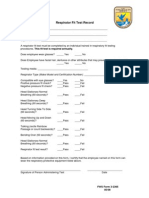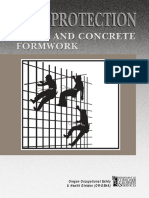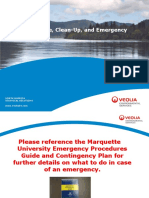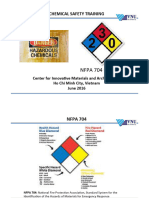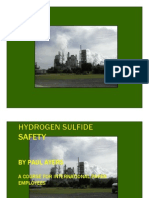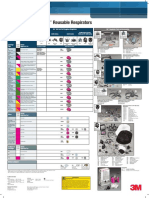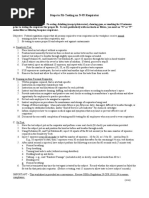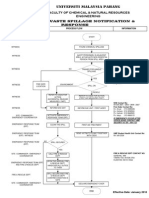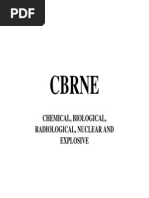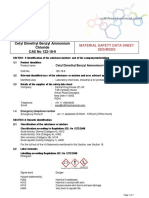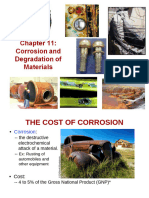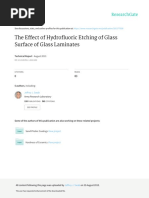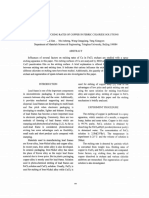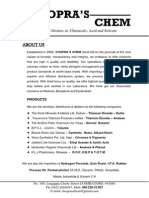How To Read SDS
How To Read SDS
Uploaded by
KumarCopyright:
Available Formats
How To Read SDS
How To Read SDS
Uploaded by
KumarOriginal Title
Copyright
Available Formats
Share this document
Did you find this document useful?
Is this content inappropriate?
Copyright:
Available Formats
How To Read SDS
How To Read SDS
Uploaded by
KumarCopyright:
Available Formats
How to Read A Safety Data Sheet (SDS)
Safety Data Sheets (SDS) are an important requirement of the OSHA Hazard Communication Standard. SDS are essential documents that are
used to inform employees, students, and the general public about how materials can be safely handled, used, and stored. Since Flinn provides
chemicals only to schools, we have written Flinn SDS specifically for teachers and their students. Using clear and straightforward language, each
Flinn SDS provides all the relevant safety and hazard information in a consistent, useful, and easy-to-read two-page format. Flinn SDS follow
the Globally Harmonized System of Classification and Labeling of Chemicals (GHS). The 16 sections are divided into four major areas, each
designed to answer a specific question.
What is the material and what do I need to
know immediately in an emergency?
Sections 1–3. LINN CIENTIFIC NC
SDS #: 181.00
Safety Data Sheet (SDS)
Revision Date: September 25, 2014
A It is important that the chemical name
on the label match the name on the SDS. Many SECTION 1 — CHEMICAL PRODUCT AND COMPANY IDENTIFICATION
chemicals have similar names, but very different n-Butyl Alcohol
properties. A
Flinn Scientific, Inc. P.O. Box 219 Batavia, IL 60510 (800) 452-1261 C D
Pictograms
CHEMTREC Emergency Phone Number: (800) 424-9300 Signal Word DANGER
B The most important section! Provides an
SECTION 2 — HAZARDS IDENTIFICATION
overview of the physical and health hazard risks
Hazard class: Flammable liquids (Category 3). Flammable liquid and vapor (H226). Keep away from heat,
associated with using the material.
sparks, open flames, and hot surfaces. No smoking (P210).
B
Hazard class: Acute toxicity, oral (Category 4). Harmful if swallowed (H302). Do not eat, drink or smoke when
C Signal words, either Danger or Warning, using this product (P270).
heighten the awareness of the relative risk when Hazard class: Skin corrosion or irritation (Category 2). Causes skin irritation (H315).
using certain chemicals. Danger is the more severe
warning! Hazard class: Serious eye damage/eye irritation (Category 1). Causes serious eye damage (H318).
Hazard class: Specific target organ toxicity, single exposure; respiratory tract irritation (Category 3). May cause
D Eight pictograms exist in the GHS classifica- respiratory irritation (H335).
tion scheme to call attention to physical and health Hazard class: Specific target organ toxicity, single exposure; Narcotic effects (Category 3). May cause
hazards. See page 1238 for more information about drowsiness or dizziness (H336). Avoid breathing mist, vapors or spray (P261).
GHS pictograms.
SECTION 3 — COMPOSITION, INFORMATION ON INGREDIENTS
Formula
Component Name CAS Number Formula Weight Concentration
E This section includes the formula, formula n-Butyl alcohol 71-36-3 CH3(CH2)2CH2OH 74.12
weight, concentration, and CAS#. The CAS# is E
the single identifying number for each specific
substance. CAS# should match the CAS# on the
bottle label. Synonym: 1-Butanol; n-Butanol
SECTION 4 — FIRST AID MEASURES
Call a POISON CENTER or physician if you feel unwell (P312). F
If inhaled: Remove victim to fresh air and keep at rest in a position comfortable for breathing (P304+P340).
If in eyes: Rinse cautiously with water for several minutes. Remove contact lenses if present and easy to do. Continue rinsing
What should I do if a hazardous (P305+P351+P338).
situation occurs? If on skin (or hair): Immediately remove all contaminated clothing. Rinse skin with water (P303+P361+P353).
If swallowed: Rinse mouth. Call a POISON CENTER or physician if you feel unwell (P302+P301+P312).
Sections 4–6.
SECTION 5 — FIRE FIGHTING MEASURES
Class 1C flammable liquid. G NFPA CODE
F Seek medical attention. These first-aid Flash point: 37 oC Flammable limits: Lower: 1.4% Upper: 11.2% Autoignition Temperature: 343 oC H-2
When heated to decomposition, may emit toxic fumes. F-3 H
measures are only meant for immediate first aid In case of fire: Use triclass dry chemical fire extinguisher (P370+P378). R-0
and should always be followed up with profes-
sional medical care. The CAS# is the single
identifying number for each specific substance. SECTION 6 — ACCIDENTAL RELEASE MEASURES
CAS# should match the CAS# on the bottle label. Remove all ignition sources and ventilate area. Contain the spill with sand or other inert absorbent material and deposit in a sealed
bag or container. See Sections 8 and 13 for further information.
I
G This section is written for the firefighter. Flash © 2015 Flinn Scientific, Inc. All Rights Reserved. PAGE 1 OF 2
point (the lowest temperature at which enough
vapor is present to form an ignitable mixture with
air); upper and lower flammable limits; and the
auto ignition temperature (AIT) are common prop-
erties included in this section. H The NFPA code is a numerical code estab- I How to clean up a spill. Always remove
lished by the National Fire Protection Association. unprotected personnel from area and make sure
It rates the substance under fire conditions in four all students are safe. Contain the spill with sand
categories. Health, Flammability, Reactivity, or absorbent materials.
and unusual reactivity: 4 is a severe hazard, 0
is no hazard.
HOW TO READ A SAFTEY DATA SHEET (SDS) continued on next page.
How to Read A Safety Data Sheet (SDS), continued
Each Flinn SDS follows the same format and the information is always found in the same location, making it a valuable resource in the event of
an emergency. With your first chemical order of the year, every teacher will receive a CD from Flinn Scientific containing all of our SDS. You
may also request another CD at any time. Flinn SDS are updated on a regular basis, guaranteeing the most up-to-date safety information possible.
Flinn sells a complete SDS Library in two versions, a hard copy version in two binders (Catalog No. AP7703, page 1206) or as part of the Flinn
Online Chemventory program. For a more detailed description of the Flinn Online Chemventory program, please refer to pages 1196–1197. For
our customers’ convenience, Flinn has also placed a free complete set of SDS on our website. Simply go to www.flinnsci.com and click on the
Free SDS button—individual SDS are easy to find and copies may be printed from your computer.
How can I prevent hazardous situations
from occurring?
FLINN SCIENTIFIC, INC. Sections 7–11.
Safety Data Sheet n-Butyl Alcohol SDS #: 181.00
Revision Date: September 25, 2015
J Use the Flinn Suggested Chemical Storage
SECTION 7 — HANDLING AND STORAGE Pattern to prevent accidents and improve safety.
Flinn Suggested Chemical Storage Pattern: Organic #2. Store with alcohols, glycols, amines, and amides. Special storage and usage tips are also included.
TM
Store in a dedicated flammables cabinet. If a flammables cabinet is not available, store in Flinn Saf-Stor can. J
Keep container tightly closed (P233). Keep cool (P235). Use only in a well-ventilated area or in a hood (P271).
K Wear personal protective equipment such as
SECTION 8 — EXPOSURE CONTROLS, PERSONAL PROTECTION goggles, gloves, and an apron. See page 1226–
Wear protective gloves, protective clothing and eye protection (P280). Wash thoroughly after handling (P264). Use ventilation to 1227 for an explanation of exposure guidelines.
keep airborne concentrations below exposure limits.
Exposure guidelines: PEL 100 ppm (OSHA) TLV 20 ppm (ACGIH) K
L Clear, concise, and useful physical and
SECTION 9 — PHYSICAL AND CHEMICAL PROPERTIES chemical properties help you learn more about
Clear colorless liquid. Wine-like odor. Boiling point: 117.7 C
o
the chemicals you use. The first part describes
o
Soluble: Water (20%). Miscible with alcohol and ether. Melting point: -89 C the material’s appearance. If it doesn’t look like
L Refractive index: 1.3988 this, STOP. Do not use it. It may be more or less
Specific gravity: 0.81
hazardous.
SECTION 10 — STABILITY AND REACTIVITY
Avoid contact with aluminum, chromium trioxide, and oxidizing materials. M Describes the conditions or reactions to be
Substance may develop explosive hydroperoxides. M avoided. Also provides some indication about
Shelf life: Fair, substance may oxidize. See Section 7 for further information.
anticipated shelf life.
SECTION 11 — TOXICOLOGICAL INFORMATION
Acute effects: Absorbed through skin. Eye, skin, respiratory tract ORL-RAT LD50: 790 mg/kg N More detail on how the material may injure
irritation. Dizziness. CNS depression. IHL-RAT LC50: 8000 ppm/4H
Chronic effects: N.A. N SKN-RBT LD50: 3400 mg/kg O you. Acute (short exposure) and chronic (long-
Target organs: Eyes, skin, respiratory system, central nervous term) effects are listed along with their target
system. organs.
N.A. = Not available, not all health aspects of this substance have been fully investigated.
SECTION 12 — ECOLOGICAL INFORMATION
O Oral (ORL), inhalation (IHL), and skin
Data not yet available. P absorption (SKN) toxicity data on test animals is
SECTION 13 — DISPOSAL CONSIDERATIONS included. For more information on LD50, see pages
Please review all federal, state and local regulations that may apply before proceeding. 1228–1229.
Flinn Suggested Disposal Method #18b is one option. Q
Other useful information.
SECTION 14 — TRANSPORT INFORMATION
Shipping name: Butanols. Hazard class: 3, Flammable Liquid. UN number: UN1120. Sections 12–16.
N/A = Not applicable R
P Ecological impact if large amounts (e.g., tank
SECTION 15 — REGULATORY INFORMATION
TSCA-listed, EINECS-listed (200-751-6), RCRA code U031. S car) of the chemical spill near a river or lake.
SECTION 16 — OTHER INFORMATION
This Safety Data Sheet (SDS) is for guidance and is based upon information and tests believed to be reliable. Flinn Scientific, Inc. makes no guarantee of the accuracy or
completeness of the data and shall not be liable for any damages relating thereto. The data is offered solely for your consideration, investigation, and verification. The
Q Suggested disposal methods for laboratory
data should not be confused with local, state, federal or insurance mandates, regulations, or requirements and CONSTITUTE NO WARRANTY. Any use of this data and
information must be determined by the science instructor to be in accordance with applicable local, state or federal laws and regulations. The conditions or methods of quantities of chemicals. See pages 1268–1298 for
handling, storage, use and disposal of the product(s) described are beyond the control of Flinn Scientific, Inc. and may be beyond our knowledge. FOR THIS AND OTHER
REASONS, WE DO NOT ASSUME RESPONSIBILITY AND EXPRESSLY DISCLAIM LIABILITY FOR LOSS, DAMAGE OR EXPENSE ARISING OUT OF OR IN ANY Flinn Suggested Disposal Methods.
WAY CONNECTED WITH THE HANDLING, STORAGE, USE OR DISPOSAL OF THIS PRODUCT(S).
T
Consult your copy of the Flinn Science Catalog/Reference Manual for additional information about laboratory chemicals.
R Department of Transportation shipping
© 2016 Flinn Scientific, Inc. All Rights Reserved. PAGE 2 OF 2
information is included for your school district,
emergency responders, and transport/shipping
departments.
S Regulatory information used by regulatory T Flinn Scientific has an ongoing program to
compliance personnel. update its SDS. As professional chemists, we try
our best to provide science teachers with the most
accurate and useful safety information. Call Flinn
if you have any questions. We can help!
You might also like
- Emergency Assistance Plan by TW 12oct21Document7 pagesEmergency Assistance Plan by TW 12oct21Than WinNo ratings yet
- WHMIS ChineseDocument48 pagesWHMIS ChineseSm KimNo ratings yet
- Apf NPF EuropeDocument24 pagesApf NPF EuropeTammanurRavi100% (1)
- Fit Testing Government FormDocument1 pageFit Testing Government FormJorge TorresNo ratings yet
- Dynamic Modeling Using Aspen HYSYS® For Oil and Gas - Course Number EB1105.06.04Document205 pagesDynamic Modeling Using Aspen HYSYS® For Oil and Gas - Course Number EB1105.06.04Kumar100% (9)
- Halon Extinguishing Agents: Safety & Health ConcernsDocument4 pagesHalon Extinguishing Agents: Safety & Health ConcernskbonairNo ratings yet
- CH 2-HSE Risks Management - Hazard Identification - Major HAZARDSDocument69 pagesCH 2-HSE Risks Management - Hazard Identification - Major HAZARDSbaaziz2015No ratings yet
- Fall Protection Concrete PDFDocument20 pagesFall Protection Concrete PDFテレブリコ ジェファーソンNo ratings yet
- Respiratory Protection Training 15022022Document19 pagesRespiratory Protection Training 15022022fgdgrte gdfsgdNo ratings yet
- Spill Response, Clean-Up, and Emergency Response: North America Technical SolutionsDocument20 pagesSpill Response, Clean-Up, and Emergency Response: North America Technical Solutionsfarrukh husnainNo ratings yet
- Water SurvivalDocument48 pagesWater SurvivalFaith NicolaiNo ratings yet
- Lab Waste Management 3 - PSMDocument60 pagesLab Waste Management 3 - PSMAzidy AzizNo ratings yet
- ColdWater SurvivalDocument49 pagesColdWater Survivalinocenciogian7No ratings yet
- MSDS TerminologiesDocument102 pagesMSDS TerminologiesEtta JeneeNo ratings yet
- Chemical_Safety_Training-INOMARDocument30 pagesChemical_Safety_Training-INOMARTuấn Nguyễn QuốcNo ratings yet
- H2S PDFDocument49 pagesH2S PDFList EngineeringcompanyNo ratings yet
- Calgaz Nitrogen 50003 SDSDocument8 pagesCalgaz Nitrogen 50003 SDSMarthin PurbaNo ratings yet
- Basic OSH Module 1b Fire Prevention Fire FightingDocument19 pagesBasic OSH Module 1b Fire Prevention Fire FightingCarl Louise RostataNo ratings yet
- Fluor U&O Project Fall Protection and Working at Heights TrainingDocument68 pagesFluor U&O Project Fall Protection and Working at Heights TrainingjhoniNo ratings yet
- Incident Action Plan 1Document23 pagesIncident Action Plan 1api-722103421No ratings yet
- Pyrogel XT - Data SheetDocument2 pagesPyrogel XT - Data SheetBob KmnNo ratings yet
- Have You Been SET-UP? A Brief Discussion On Job Hazard Analysis (Jha)Document30 pagesHave You Been SET-UP? A Brief Discussion On Job Hazard Analysis (Jha)Ian KoNo ratings yet
- Basic Air MonitoringDocument90 pagesBasic Air MonitoringAbdulmajeedNo ratings yet
- Hydrogen Sulphide (H2S)Document40 pagesHydrogen Sulphide (H2S)ANSHUL HIKERNo ratings yet
- OSHA3767 Appendix DDocument33 pagesOSHA3767 Appendix Dgensai kNo ratings yet
- MSDS KresolDocument6 pagesMSDS Kresolshinta sariNo ratings yet
- "Danger Floor Opening 100% Tie-Off Required" or "Danger Hole - Do Not Remove Cover"Document2 pages"Danger Floor Opening 100% Tie-Off Required" or "Danger Hole - Do Not Remove Cover"MyolwinooNo ratings yet
- 37 Percent Formaldehyde Aqueous Solution Mixture of Hcho Ch3oh and H2o Sds p6224 PDFDocument12 pages37 Percent Formaldehyde Aqueous Solution Mixture of Hcho Ch3oh and H2o Sds p6224 PDFakramNo ratings yet
- Respiratory Protective Equipment (RPE) : Offshore Coshh EssentialsDocument3 pagesRespiratory Protective Equipment (RPE) : Offshore Coshh Essentialsjnacer nacerNo ratings yet
- Chemical Safety & HazComDocument81 pagesChemical Safety & HazComLei LopezNo ratings yet
- Safety Issues in Petroleum Upstream Industry (16.6.2018)Document40 pagesSafety Issues in Petroleum Upstream Industry (16.6.2018)AKSHAY SHEKHAWATNo ratings yet
- Compressed Gas SafetyDocument90 pagesCompressed Gas Safetym_alodat6144No ratings yet
- Confined Space Entry: Safety Manual: 5.2.1Document19 pagesConfined Space Entry: Safety Manual: 5.2.1mangesh.narkar638No ratings yet
- Fire Extinguisher e LearnDocument7 pagesFire Extinguisher e LearnplannersuperNo ratings yet
- Manual Handling PDFDocument2 pagesManual Handling PDFVITALNo ratings yet
- Topic 08 - JOB HAZARD ANALYSISDocument31 pagesTopic 08 - JOB HAZARD ANALYSISbyron eugenioNo ratings yet
- CartridgeSelectionPoster English HRDocument1 pageCartridgeSelectionPoster English HRTg TarroNo ratings yet
- Penerapan LOTODocument24 pagesPenerapan LOTOIra Rha Pracina GunartonNo ratings yet
- Fit-Test Steps For N-95 RespiratorsDocument2 pagesFit-Test Steps For N-95 RespiratorsCandyceNo ratings yet
- Kinder Morgan H2S PlanDocument8 pagesKinder Morgan H2S PlanKyran ButcherNo ratings yet
- Occupational Health Hazards and Their Control Measures in Construction WorkDocument9 pagesOccupational Health Hazards and Their Control Measures in Construction WorkSantanu Kumar SahuNo ratings yet
- Joncryl 678 TDSDocument2 pagesJoncryl 678 TDSAllen Kam100% (1)
- Compressed Gas Cylinder SafetyDocument36 pagesCompressed Gas Cylinder Safetyelvis hidalgoNo ratings yet
- Car Parks PolicyDocument3 pagesCar Parks PolicySophie-Louise MercedesNo ratings yet
- Safety TrainingDocument21 pagesSafety TrainingIbrahim100% (1)
- Pine Confined SpaceDocument31 pagesPine Confined Spacemigas_7No ratings yet
- Georgia Spill Release Reporting FlowchartDocument1 pageGeorgia Spill Release Reporting FlowchartfweNo ratings yet
- Spill Tech BrochureDocument12 pagesSpill Tech Brochuremonique5617No ratings yet
- MSDS PetrolDocument6 pagesMSDS PetrolridgellNo ratings yet
- Ansi / Asse Z88.2: American National Standard Practices For Respiratory Protection (1992 Rev. Versus 2015 Rev.)Document5 pagesAnsi / Asse Z88.2: American National Standard Practices For Respiratory Protection (1992 Rev. Versus 2015 Rev.)Laurent Dumont100% (1)
- Lsa Norm Training ExproDocument66 pagesLsa Norm Training ExproSadanandMaduskarNo ratings yet
- Chemical SpillagesDocument1 pageChemical SpillagesMuhammad ZaffanNo ratings yet
- Loss Control TipsDocument6 pagesLoss Control Tipsdnice408No ratings yet
- Chemical Spill HandlingDocument14 pagesChemical Spill HandlingJack FooNo ratings yet
- Control of Work BoardsDocument15 pagesControl of Work BoardsSamundeswaran SatiwasilanNo ratings yet
- Health Hazards PDFDocument61 pagesHealth Hazards PDFaboshokNo ratings yet
- Super SilDocument4 pagesSuper Siliwant RSTNo ratings yet
- DLM-12-50 - SDS - DLM-12 - V.3.4 - US - English USDocument11 pagesDLM-12-50 - SDS - DLM-12 - V.3.4 - US - English USLê Thị Thúy NgânNo ratings yet
- MilcideDocument7 pagesMilcideFadillah TitisariNo ratings yet
- N IsopropylcyclohexanamineDocument7 pagesN IsopropylcyclohexanaminekokoNo ratings yet
- TadasanaDocument1 pageTadasanaKumarNo ratings yet
- Guidelines For The Protection of Pressurised Systems Exposed To Fire PDFDocument81 pagesGuidelines For The Protection of Pressurised Systems Exposed To Fire PDFhiginio.moro6182No ratings yet
- Compressor Presentation 1Document28 pagesCompressor Presentation 1KumarNo ratings yet
- Name Index Number Chemical Formula Molecular WeightDocument2 pagesName Index Number Chemical Formula Molecular WeightKumarNo ratings yet
- Chapter 11 Corrosion and Degradation of MaterialsDocument35 pagesChapter 11 Corrosion and Degradation of MaterialsSKULLZER GAMINGNo ratings yet
- Elcometer 108 Hydraulic Adhesion TestersDocument2 pagesElcometer 108 Hydraulic Adhesion TestersABCNo ratings yet
- Manu and Amma PDFDocument9 pagesManu and Amma PDFkarlapudimanaswiNo ratings yet
- Chapter 34 Flammable and Combustible Liquids: General CommentsDocument5 pagesChapter 34 Flammable and Combustible Liquids: General CommentsJamesNo ratings yet
- LCADocument21 pagesLCAkashifbutty2kNo ratings yet
- Studi Pengaruh Jenis Kemasan Dan Ketebalan Plastik Terhadap KARAKTERISTIK MUTU REBUNG BAMBU TABAH (Gigantochloa Nigrociliata KURZ) KeringDocument10 pagesStudi Pengaruh Jenis Kemasan Dan Ketebalan Plastik Terhadap KARAKTERISTIK MUTU REBUNG BAMBU TABAH (Gigantochloa Nigrociliata KURZ) KeringlulalalaNo ratings yet
- Synthron Final Report1 PDFDocument17 pagesSynthron Final Report1 PDFVipin NairNo ratings yet
- Unit 4-Photosynthesis QuestionsDocument41 pagesUnit 4-Photosynthesis Questionsareyouthere92100% (3)
- ASEAN Harominzation SchemeDocument5 pagesASEAN Harominzation Schememrk_rlndNo ratings yet
- Gas NitridingDocument64 pagesGas NitridingSRIGUSTI REGA MUGIANo ratings yet
- The Effect of Hydrofluoric Etching of Glass Surface of Glass LaminatesDocument17 pagesThe Effect of Hydrofluoric Etching of Glass Surface of Glass Laminatessilent spritsNo ratings yet
- Api Standards For Coiled TubularsDocument30 pagesApi Standards For Coiled TubularstrevorfishNo ratings yet
- ChemWell R6Document234 pagesChemWell R6Tran Trong Nghia100% (1)
- Chapter 8Document89 pagesChapter 8Mustafa TataNo ratings yet
- Dust CollectorsDocument50 pagesDust Collectorsprakash bhadoria100% (1)
- Sulfur (S) PDFDocument18 pagesSulfur (S) PDFJRod100% (1)
- Moisture AnalyzerDocument12 pagesMoisture Analyzercap n3moNo ratings yet
- Hollow Fibre Membrane ModuleDocument41 pagesHollow Fibre Membrane Modulejigar patel75% (4)
- Chemical Kinetics NotesDocument31 pagesChemical Kinetics Notesthanmaynyb100% (1)
- Maharashtra Public Service Commission: Assistant Director of Forensic Science Advt No 34 of 2022Document25 pagesMaharashtra Public Service Commission: Assistant Director of Forensic Science Advt No 34 of 2022rahul.ingale09No ratings yet
- 7 - Hazards of Confined Space: Safety Training: Eh&S - MgaDocument2 pages7 - Hazards of Confined Space: Safety Training: Eh&S - MgapanjiNo ratings yet
- Chitin Chitosan ProductionDocument19 pagesChitin Chitosan ProductionOmer MukhtarNo ratings yet
- CHAPTER 1-Basic Concept of Fluid MechanicsDocument30 pagesCHAPTER 1-Basic Concept of Fluid MechanicsKogulan SubramaniamNo ratings yet
- Prabakaran 2018Document12 pagesPrabakaran 2018dilla zainudinNo ratings yet
- 17 Bản - Past Papers CheckpointDocument100 pages17 Bản - Past Papers Checkpointhoanganh.hana01No ratings yet
- Effects On Etching Rates of Copper in Ferric Chloride SolutionsDocument5 pagesEffects On Etching Rates of Copper in Ferric Chloride SolutionsMein samayNo ratings yet
- Cambridge Secondary Two Science: Chapter 8: MixturesDocument28 pagesCambridge Secondary Two Science: Chapter 8: MixturesarenestarNo ratings yet
- BYK TP-A2 GlassFiberModifiers EN 1Document6 pagesBYK TP-A2 GlassFiberModifiers EN 1bsjaNo ratings yet
- Acid Rain Lab - Julia BerardoDocument3 pagesAcid Rain Lab - Julia Berardoapi-342281543No ratings yet
- Mail Copy Profile of COPRAS CHEMDocument5 pagesMail Copy Profile of COPRAS CHEMchoprajainNo ratings yet



